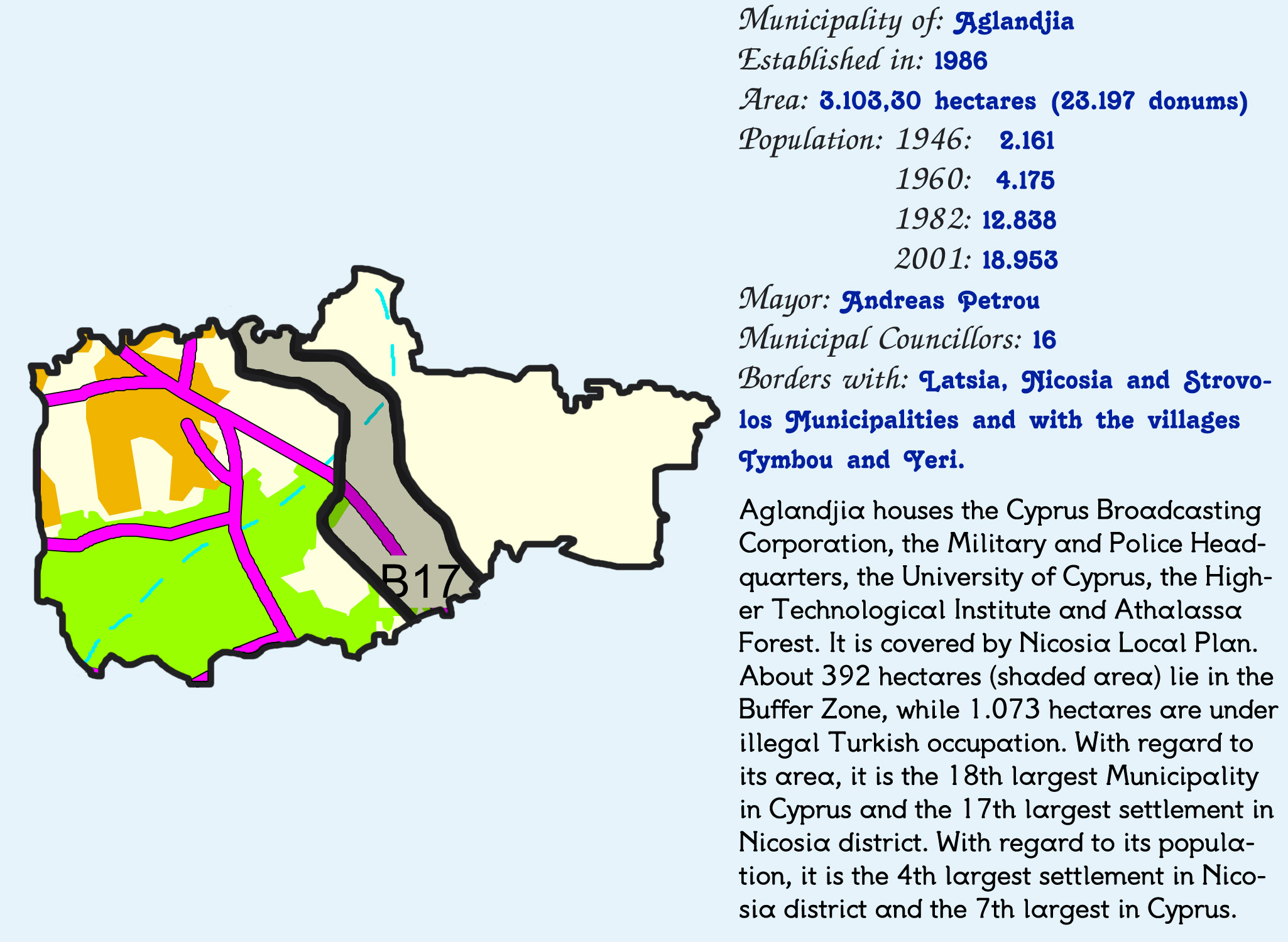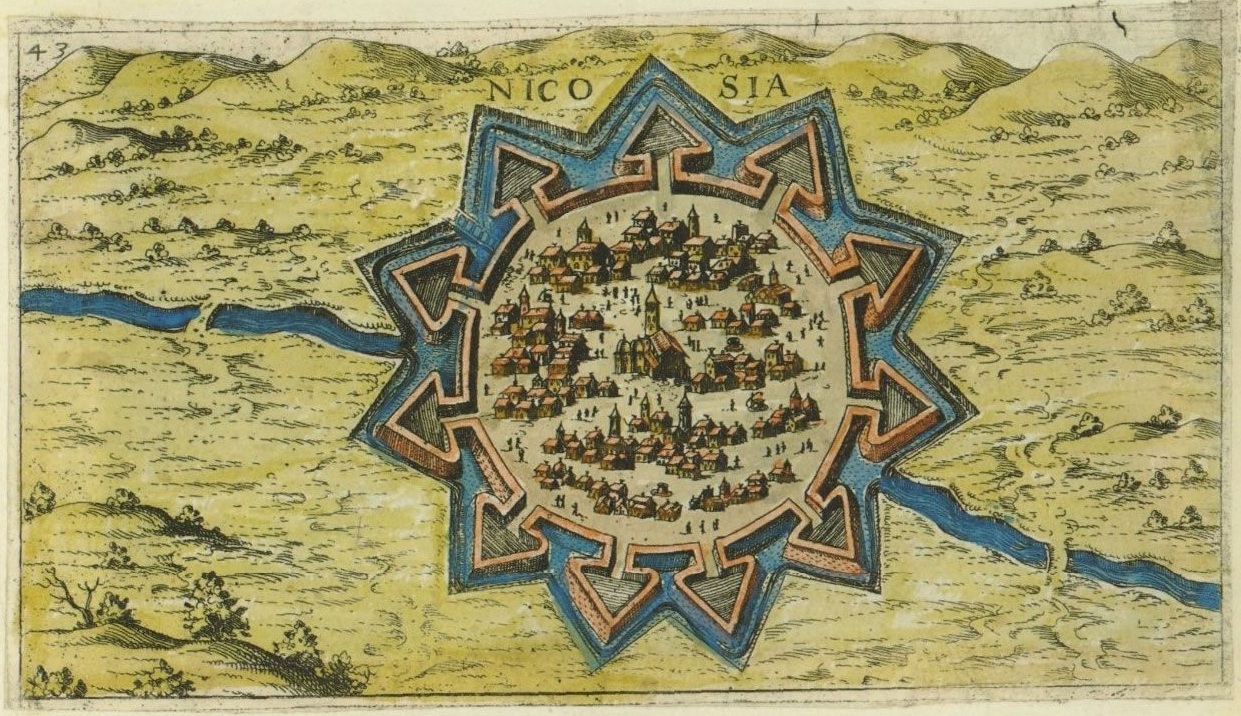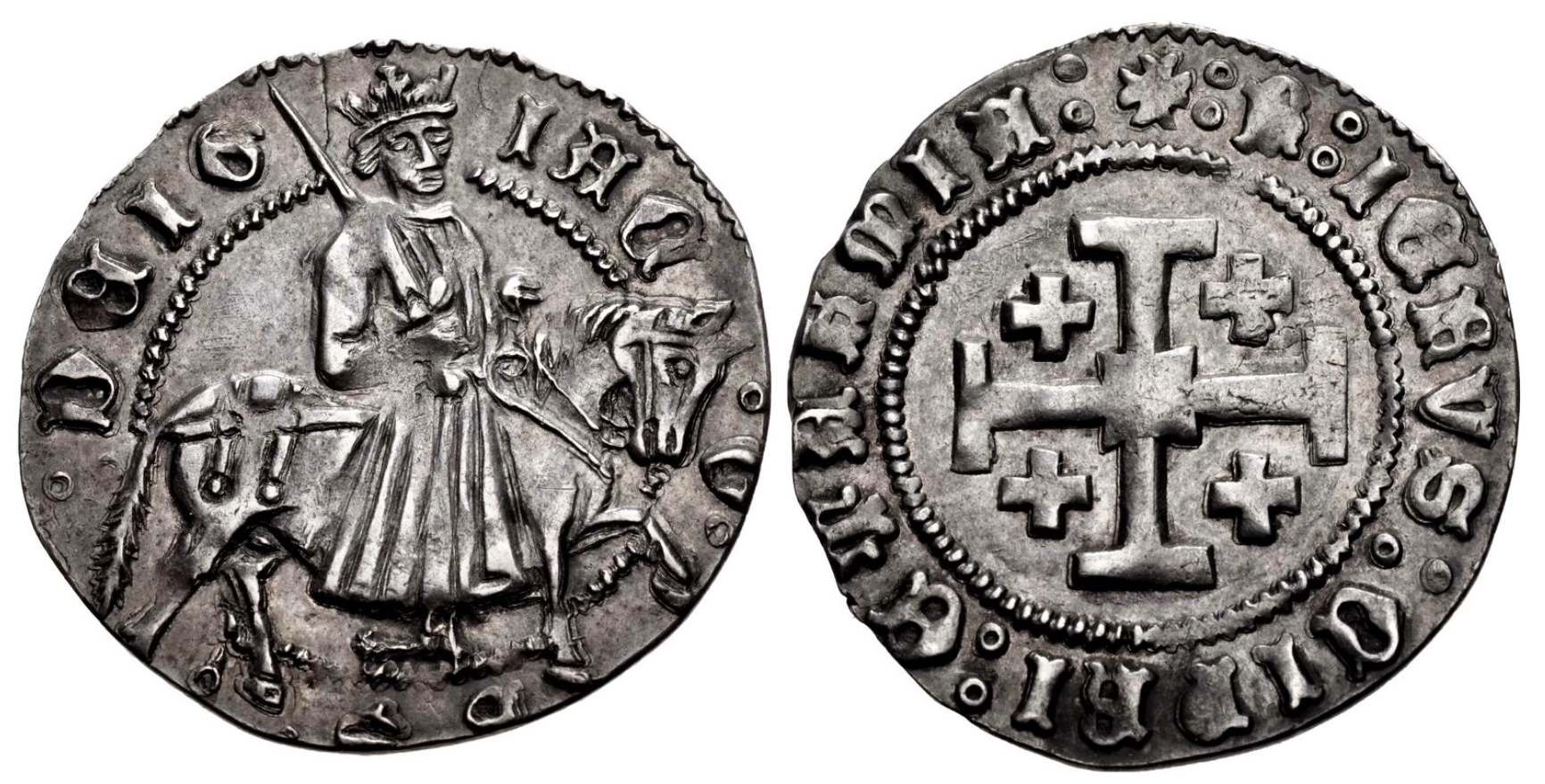|
Aglandjia
Aglandjia ( []; ) is a suburb and municipality of Nicosia, Cyprus. The municipality has a population of 20,783 (2011) and is contiguous with the Nicosia Municipality. Aglandjia is near the United Nations Buffer Zone in Cyprus, buffer zone. It has an area of about 31 km2, of which 14 km2 is agricultural land that has been Turkish invasion of Cyprus, occupied by the Turkish army since 1974; of the remaining 17 km2, 9 km2 are national forest parks (Athalassa park, 8.6 km2 and Pedagogical Academy park 0.4 km2). Name The word ''Aglandjia'' is of Turkish origin, deriving from , meaning "entertainment". Its pronunciation in Cypriot Greek is . Another theory states that the name derives from the surname of the Frankish family de Aglande, who owned the area during the Frankish rule in Middle Ages. Administration Aglandjia was declared a Municipality by a referendum in May 1986. The Municipal Council is made up of the mayor and sixteen Municipal Councilo ... [...More Info...] [...Related Items...] OR: [Wikipedia] [Google] [Baidu] |
Nicosia
Nicosia, also known as Lefkosia and Lefkoşa, is the capital and largest city of Cyprus. It is the southeasternmost of all EU member states' capital cities. Nicosia has been continuously inhabited for over 5,500 years and has been the capital of Cyprus since the 10th century. It is the last divided capital in Europe; three years after Cyprus gained independence from British rule in 1960, the Bloody Christmas conflict between Greek Cypriots and Turkish Cypriots triggered intercommunal violence, and Nicosia's Greek Cypriot and Turkish Cypriot communities segregated into its south and north respectively in 1964. A decade later, Turkey invaded Cyprus following Greece's successful attempt to take over the island. The leaders of the takeover would later step down, but the dividing line running through Nicosia (and the rest of the island, interrupted only briefly by British military bases) became a demilitarised zone that remains under the control of Cyprus while heavil ... [...More Info...] [...Related Items...] OR: [Wikipedia] [Google] [Baidu] |
Nicosia District
The Nicosia District, or simply Nicosia (also Lefkosia and Lefkoşa), is one of the six districts of Cyprus. Its main town is the island country's capital city, Nicosia. The de facto TRNC-controlled northern part of the district is the Lefkoşa District of the unrecognized Turkish Republic of Northern Cyprus. TRNC-controlled areas of the Larnaca District of the Republic of Cyprus are administered as part of Nicosia District, while western parts of the Nicosia District under de facto TRNC control are administered as part of the new Güzelyurt and Lefke Districts. History Under Lusignan rule, at least the latter part and then during the Venetian period, the Kingdom of Cyprus was divided into eleven provinces called in French contrées and in Italian contrade. The area around Nicosia was the province of Vicomté (literally the domain of a Viscount). It covered the eastern half of the present District of Nicosia, what would later become the Nahiehs of Dagh and Deyirmenlik (orange ... [...More Info...] [...Related Items...] OR: [Wikipedia] [Google] [Baidu] |
List Of Cities, Towns And Villages In Cyprus
This is a list of settlements in Cyprus. The English name is indicated first, followed by the Greek and Turkish names, in turn followed by any former names, including ones used in antiquity. Note that even though, prior to the 1974 Turkish invasion of Cyprus, Turkish names existed for some villages/towns, due to political reasons, most of the villages/towns were given a different Turkish name. The largest cities in Cyprus, in order from largest, are Nicosia ( capital), Limassol, Larnaca, Paphos, Famagusta and Kyrenia. Districts District capital cities Municipalities Minor towns and villages Settlements in Northern Cyprus Districts District capital cities Note that not all North Cyprus District capital cities are also District capital cities of the Republic of Cyprus. Municipalities Municipalities are under the de facto control of the Turkish Republic of Northern Cyprus. Turkish names were established in 1958, then some of them were alter ... [...More Info...] [...Related Items...] OR: [Wikipedia] [Google] [Baidu] |
James II Of Cyprus
James II (; /1439 or 1440 – 10 July 1473) was the penultimate King of Cyprus (usurper), reigning from 1460/1464 until his death. Archbishop of Nicosia James was born in Nicosia as the illegitimate son of John II of Cyprus and Marietta de Patras. He was a great favourite of his father, and in 1456, at the age of 16, he was appointed to the archbishopric of Nicosia. After murdering Iacopo Urri, the royal chamberlain, on 1 April 1457, he was deprived of the archbishopric and fled to Rhodes on a ship of the Catalan Juan Tafures. He was pardoned by his father, and the archbishopric was returned to him. King of Cyprus In 1458, his father died and his half-sister Charlotte became Queen of Cyprus. Then in 1460, with support from the Egyptian Mamluk sultan Sayf ad-Din Inal, James challenged her right to the throne, blockading her and her husband, Louis of Savoy, in the castle of Kyrenia for three years. Charlotte fled to Rome in 1463. With the fall of Kyrenia before the ... [...More Info...] [...Related Items...] OR: [Wikipedia] [Google] [Baidu] |
Francia
The Kingdom of the Franks (), also known as the Frankish Kingdom, or just Francia, was the largest History of the Roman Empire, post-Roman barbarian kingdom in Western Europe. It was ruled by the Franks, Frankish Merovingian dynasty, Merovingian and Carolingian dynasty, Carolingian dynasties during the Early Middle Ages. Francia was among the last surviving Germanic kingdoms from the Migration Period era. Originally, the core Frankish territories inside the former Western Roman Empire were located close to the Rhine and Meuse rivers in the north, but Frankish chiefs such as Chlodio would eventually expand their influence within Roman territory as far as the Somme (river), Somme river in the 5th century. Childeric I, a Salian Franks, Salian Frankish king, was one of several military leaders commanding Roman forces of various ethnic affiliations in the northern part of what is now France. His son, Clovis I, succeeded in unifying most of Gaul under his rule in the 6th century by ... [...More Info...] [...Related Items...] OR: [Wikipedia] [Google] [Baidu] |
Larnaca
Larnaca, also spelled Larnaka, is a city on the southeast coast of Cyprus and the capital of the Larnaca District, district of the same name. With a district population of 155.000 in 2021, it is the third largest city in the country after Nicosia and Limassol. Built on the ruins of Kition, Citium, the Ancient Greece, Ancient Greek city-state best known as the birthplace of stoicism, Stoic philosopher Zeno of Citium, Larnaca is home to the Church of Saint Lazarus, Larnaca, Church of Saint Lazarus, Hala Sultan Tekke, Kamares Aqueduct, Larnaca Castle, Larnaca District Archaeological Museum, and Pierides Museum. It attracts many visitors to its beaches, as well as Finikoudes (Φοινικούδες; Greek for "palm trees"), its signature seafront promenade lined with palm trees. It gives its name to the country's primary airport, Larnaca International Airport, which is situated in the neighbouring village of Dromolaxia rather than Larnaca proper. It also has a seaport and a marina. ... [...More Info...] [...Related Items...] OR: [Wikipedia] [Google] [Baidu] |
Middle Ages
In the history of Europe, the Middle Ages or medieval period lasted approximately from the 5th to the late 15th centuries, similarly to the post-classical period of global history. It began with the fall of the Western Roman Empire and transitioned into the Renaissance and the Age of Discovery. The Middle Ages is the middle period of the three traditional divisions of Western history: classical antiquity, the medieval period, and the modern period. The medieval period is itself subdivided into the Early, High, and Late Middle Ages. Population decline, counterurbanisation, the collapse of centralised authority, invasions, and mass migrations of tribes, which had begun in late antiquity, continued into the Early Middle Ages. The large-scale movements of the Migration Period, including various Germanic peoples, formed new kingdoms in what remained of the Western Roman Empire. In the 7th century, North Africa and the Middle East—once part of the Byzantine Empire� ... [...More Info...] [...Related Items...] OR: [Wikipedia] [Google] [Baidu] |
Park In Aglandjia During Summer Season In Nicosia Republic Of Cyprus
A park is an area of natural, semi-natural or planted space set aside for human enjoyment and recreation or for the protection of wildlife or natural habitats. Urban parks are urban green space, green spaces set aside for recreation inside towns and cities. National parks and country parks are green spaces used for recreation in the countryside. State parks and provincial parks are administered by sub-national government states and agencies. Parks may consist of grassy areas, rocks, soil and trees, but may also contain buildings and other artifacts such as monuments, fountains or playground structures. Many parks have fields for playing sports such as baseball and football, and paved areas for games such as basketball. Many parks have trails for walking, biking and other activities. Some parks are built adjacent to bodies of water or watercourses and may comprise a beach or boat dock area. Urban parks often have benches for sitting and may contain picnic tables and barbecue gr ... [...More Info...] [...Related Items...] OR: [Wikipedia] [Google] [Baidu] |
Ptolemaic Dynasty
The Ptolemaic dynasty (; , ''Ptolemaioi''), also known as the Lagid dynasty (, ''Lagidai''; after Ptolemy I's father, Lagus), was a Macedonian Greek royal house which ruled the Ptolemaic Kingdom in Ancient Egypt during the Hellenistic period. Reigning for 275 years, the Ptolemaic was the longest and last dynasty of ancient Egypt from 305 BC until its incorporation into the Roman Republic in 30 BC. Ptolemy, a general and one of the '' somatophylakes'' (bodyguard companions) of Alexander the Great, was appointed satrap of Egypt after Alexander's death in 323 BC. In 305 BC he declared himself Pharaoh Ptolemy I, later known as ''Sōter'' "Saviour". The Egyptians soon accepted the Ptolemies as the successors to the pharaohs of independent Egypt. The new dynasty showed respect to local traditions and adopted the Egyptian titles and iconography, while also preserving their own Greek language and culture. The Ptolemaic period was marked by the intense interactions and blending ... [...More Info...] [...Related Items...] OR: [Wikipedia] [Google] [Baidu] |
Hellenistic Period
In classical antiquity, the Hellenistic period covers the time in Greek history after Classical Greece, between the death of Alexander the Great in 323 BC and the death of Cleopatra VII in 30 BC, which was followed by the ascendancy of the Roman Empire, as signified by the Battle of Actium in 31 BC and the Roman conquest of Ptolemaic Egypt the following year, which eliminated the last major Hellenistic kingdom. Its name stems from the Ancient Greek word ''Hellas'' (, ''Hellás''), which was gradually recognized as the name for Greece, from which the modern historiographical term ''Hellenistic'' was derived. The term "Hellenistic" is to be distinguished from "Hellenic" in that the latter refers to Greece itself, while the former encompasses all the ancient territories of the period that had come under significant Greek influence, particularly the Hellenized Middle East, after the conquests of Alexander the Great. After the Macedonian conquest of the Achaemenid Empire in ... [...More Info...] [...Related Items...] OR: [Wikipedia] [Google] [Baidu] |
Worship
Worship is an act of religious devotion usually directed towards a deity or God. For many, worship is not about an emotion, it is more about a recognition of a God. An act of worship may be performed individually, in an informal or formal group, or by a designated leader. Such acts may involve honoring. Etymology The word is derived from the Old English , meaning ''to venerate "worship, honour shown to an object or deity'',Bosworth and Toller, Anglo-Saxon Dictionary,weorþscipe which has been etymologised as "''worthiness'' or ''worth-ship"''—to give, at its simplest, worth to something. Worship in various religions Buddhism Worship in Buddhism may take innumerable forms given the doctrine of skillful means. Worship is evident in Buddhism in such forms as: guru yoga, mandala, thanka, yantra yoga, the discipline of the fighting monks of Shaolin, panchamrita, mantra recitation, tea ceremony, ganacakra, amongst others. Buddhist Devotion is an important part of the pra ... [...More Info...] [...Related Items...] OR: [Wikipedia] [Google] [Baidu] |








